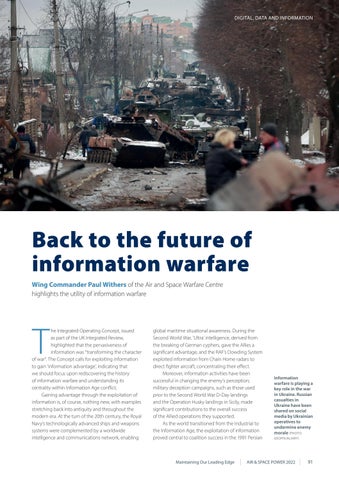DIGITAL, DATA AND INFORMATION
Back to the future of information warfare Wing Commander Paul Withers of the Air and Space Warfare Centre highlights the utility of information warfare
T
he Integrated Operating Concept, issued as part of the UK Integrated Review, highlighted that the pervasiveness of information was “transforming the character of war”. The Concept calls for exploiting information to gain ‘information advantage’, indicating that we should focus upon rediscovering the history of information warfare and understanding its centrality within Information Age conflict. Gaining advantage through the exploitation of information is, of course, nothing new, with examples stretching back into antiquity and throughout the modern era. At the turn of the 20th century, the Royal Navy’s technologically advanced ships and weapons systems were complemented by a worldwide intelligence and communications network, enabling
global maritime situational awareness. During the Second World War, ‘Ultra’ intelligence, derived from the breaking of German cyphers, gave the Allies a significant advantage, and the RAF’s Dowding System exploited information from Chain Home radars to direct fighter aircraft, concentrating their effect. Moreover, information activities have been successful in changing the enemy’s perception; military deception campaigns, such as those used prior to the Second World War D-Day landings and the Operation Husky landings in Sicily, made significant contributions to the overall success of the Allied operations they supported. As the world transitioned from the Industrial to the Information Age, the exploitation of information proved central to coalition success in the 1991 Persian
Maintaining Our Leading Edge
Information warfare is playing a key role in the war in Ukraine. Russian casualties in Ukraine have been shared on social media by Ukrainian operatives to undermine enemy morale (PHOTO: GEOPIX/ALAMY)
AIR & SPACE POWER 2022
91
